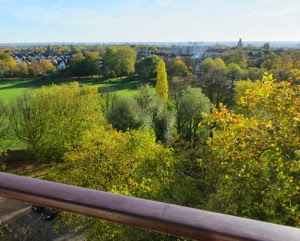It was good to discover some of our pre-Christian roots in several local villages, stone circles and churches, the latter with roots going back to around 600AD when a local person with healing abilities would be made a saint by the local bishop and a church (re-)dedicated to them. The continuity of sanctity down the millennia is very apparent here, as indeed it is in many country places. Holy places have been holy places for a very long time, often romanised in Roman Britain, then Christianised around 600AD either as a result of St David et al from the west or St Augustine and others from the east. Look out for ancient circular churchyards. Why circular? So the devil can't hide in a corner…
Of course west Cornwall means going to St Ives. Quite a culture shock after the villages and coastal landscapes further west. Because of the people. Huh? Well, so many FAT people suddenly. St Ives is an art mecca, yes, but it's also a resort with infinite sandy beaches mostly sheltered at least in part from southerly and southwesterly winds. Visitors to the Tate and to the Barbara Hepworth Gallery and Sculpture Garden (the latter quite compact and hopelessly unsuited to crowds), along with hikers on the coastal path which can be quite demanding round there, mix (or don't) uneasily with the shuffling hordes of chip eaters and ice cream suckers who lurch slowly and unevenly along the roads and block the pavements.
Part way round the Tate I suddenly started seeing the exhibition as one of plinths. Actually this observation began in the Hepworth gallery, where you suddenly notice that every single sculpture (though with very rare exceptions) is perched on a rectangular white box made probably of marine ply. Why is such a boring and repetitive plinth, painted in shining white that soon shows the dirt, judged to be suitable for almost any sculpture of any texture, shape or colour? Because, very obviously, it often detracts and distracts from the artwork in question. Here is a display of plinths in the Tate, these behind glass: imagine statues in a garden perched on these things!
The slideshow below takes you round some of the ancient sites: I merely scraped the surface of what is there. The holy well at Madron was the big experience, discovering that a site that was holy and sanctified at least as early as 600AD is still visited and revered for its healing properties today, with people tying votive favours on the branches of the trees and doubtless drinking from the stream.










